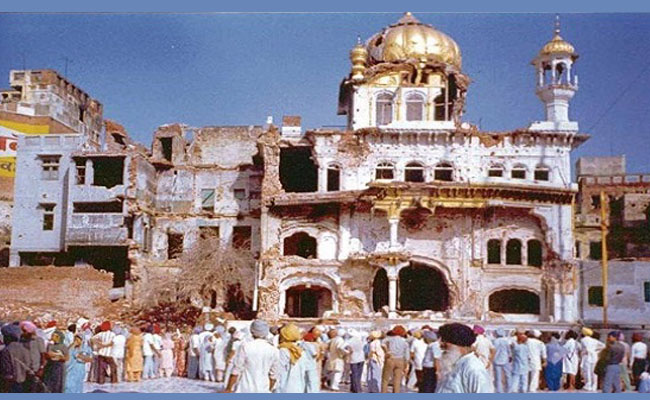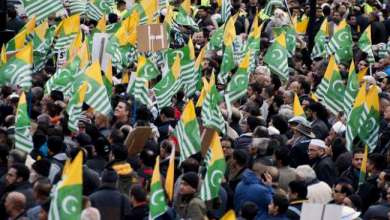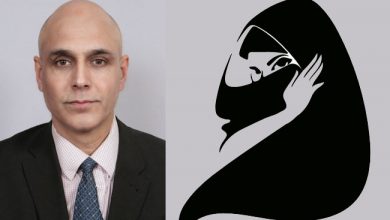Painful remembrance of the Indian State Terrorism against the Sikhs

Written by: Dr Iqtidar Cheema
This week; Sikhs around the world are remembering the attack of Indian Army on the Golden temple and Akal Takhat in Amritsar. The attack which is commonly known as ‘operation Blue Star’ took place 36 years ago during June 1984. The attack is a worst example of the state terrorism, used by authoritarian and totalitarian government of India against its own citizens, to make any form of political opposition impossible. G.K.C Reddy in his book ‘Army Action in Punjab’ has rightly said that ‘Operation Blue Star will go down in history as one of the biggest massacres of unarmed civilians by the organised military force of a nation’. Walter Laqueur has may be remarked for such acts of state terrorism that ‘ acts of terror carried out by despotic states and tyrannical governments, in general, has been responsible for a thousand time more victims and more misery than all individual act of terrorism taken together’.
Indeed, of the religious communities in India, the Sikhs probably possess the strongest sense of their own identity and community. The Sikhs characterise themselves by their unflinching allegiance to their ten gurus and their teachings, the holy book Sri Guru Granth Sahib, and their pilgrimage of their shrines. Sri Harminder Sahib, Amritsar commonly known as The Golden Temple has been the foremost center of Sikh pilgrimage. The Akal Takhat (the throne of the timeless one) is also an impressive building that sits directly in front of the causeway leading to the Golden Temple. It is the highest political institution of the Sikhs. The Akal Takhat was founded by Guru Hargobind in 1606 and was established as the place from where the spiritual and temporal concerns of the Sikh community could be acted upon. By the end of the nineteenth century, Hindus and Sikhs each embarked upon competing religious resumptions. This resulted in communal lines becoming more distinct and antagonistic. The Hindus started the Arya Samaj movement and, in retaliation, the Sikhs started the Singh Sabha movement (1870-1919). The Arya Samaj did spread anti-Sikh propagandas. The Singh Sabha, on its part, focused on clearing out fragments of Hinduism from Sikhism. The main thrust of the Singh Sabha was about clear demarcation of Sikh communal identity and the defense of the Sikh religion from attacks by other religions.
The Sikhs initially demanded for a separate Sikh state to protect their economic, religious, and cultural identity. This demand was made in the context of the partitioning of the country into India and Pakistan on religious basis. However, the Sikhs finally gave up their demand for a separate State after Congress leaders promised that Sikhs would have a special status in independent India.The 1947 partition also meant the division of Punjab. From Pakistani Punjab, about 4 million Hindus and Sikhs migrated to India. Sikhs were staunch nationalists at that time, but later on, they agitated. Immediately after independence, Sikh princely states were merged with the Indian Punjab province and the privileges enjoyed by them during the British period were done away with. India was declared as a ‘socialist secular state’, special representation of Sikhs withdrawn and joint electorate was introduced in place of separate electorate.Punjab had 56% Sikh population even after the creation of Haryana and Himachal Pardesh provinces carved out of it. But the prosperity of Punjab attracted a large number of Hindus to the province thereby reducing Sikh majority to 52%. Grievances grew during the 1960s as Sikhs began to feel that their religion and their social structure faced the subtle threat of absorption into Hinduism. Before partition of India, Congress had always exploited and supported that demand for the creation of linguistic states. After upheaval of independence Congress dissociated itself from this demand. Government bowed down in 1953 and Andhra Pradesh was the first state to be created on language basis. But Punjab had to wait for 10 years for a Punjabi Suba.
Sikhs were further aggrieved when, during the census of 1951 and 1961, Punjabi Hindus declared Hindi as their mother-language even when they could not speak it.This communal tension initially marked Sikhism as distinct from Hinduism. Thus it was left to the Sikhs to preserve their ethnicity through the preservation of Punjabi language written in Gurmukhi script. Another grievance of Punjab against the Government of India was about the distribution of waters between Punjab, Haryana and Rajasthan.Punjab alleged the excess was allowed to flow into the states of Haryanan and Rajasthan at the cost of Punjab. The Punjab Reorganisation Act resulted in Punjab losing close to 75% of its riverine waters to the Hindu-dominated states of Haryana and Rajasthan.
The Indian constitution states that all persons are equally entitled to freely profess and practice their religion. This allowed the Sikhs the wearing of ‘Kirpans’. They could carry a nine inch long Kirpan even on domestic flights but the government did not allow such freedom on international flights of Air India.
For the redressal of Sikh grievances Jarnail Singh Bhindranwale came to the forefront. He represented religious heroism and a new glamour was given to Sikh demands by his unbridled struggle and courage. He soon mobilised a massive following amongst Sikhs in and outside Punjab. He became an extremely popular Sikh leader. Having gained adequate influence. As a result of mounting tension between Sikhs and Hindus, Hindu extremist organizations such as RSS became more active and new ones such as Hindu Suraksha Samiti, Bajrang Brigade and Shiv Sena were established to attack Sikhs in Punjab. In the beginning of 1984, situation in Punjab was dangerous and had reached the point of no-return, Sikhs being pushed almost to the wall. After a record harvest in 1984, Punjab threatened to stop supply of grain out of the state. The threat of a possible closure of Punjab breadbasket “provided Indra Gandhi with the perfect pretext if one was needed, to send in the army.”
On 2 June, Indian army surrounded Golden Temple. About 150,000 Indian army troops sent to the state of Punjab, with helicopter gunships, tanks and modern weaponry. The state was sealed off from the external world. Journalists were removed. Telephone lines were cut, preventing internal and external communication.All news and information was controlled by the Indian government. All independent newspapers and radio stations were closed down. An indefinite curfew was imposed across the whole of Punjab, with 20 million residents placed in a state of seige and imprisonment.
On 4 June 1984, India’s Prime Minister Indira Gandhi ordered the Indian Army to invade the Golden Temple complex in Amritsar. As it was the anniversary of the martyrdom of the Sikhs’ 5th Guru, Guru Arjun Dev, it was full of thousands of pilgrims. Forty other Sikh shrines were simultaneously attacked using massive fire power. On the excuse of apprehending ‘a handful of armed men’ lodged inside the Golden Temple, the Indian Army unleashed a terror unprecedented in post-independence India. Indian army used the Vijayanta tanks to win the fight. These let loose a barrage of highly explosive shells, which tore off the entire front of the Akal Takht, the temporal seat of the Sikhs, setting off fires in many of its internal rooms (some of which housed precious historical sikh relics), and badly damaged its dome.With dead bodies lying all around, the vast lake of the Golden temple Complex was
transformed into a thick red of profuse blood. No attempts were made to provide assistance to the injured or dying. Christian Science Monitor reported, "On Saturday, medical workers in Amritsar said soldiers had threatened to shoot them if they gave food or water to Sikh pilgrims wounded in the attack and lying in the hospital".
In an effort to destroy a crucial part of Sikh heritage, Indian army deliberately set fire to the Sikh Reference Library within the complex, after it had been secured. Irreplaceable copies of the Sikhs’ holy book Guru Granth Sahib, the Sikhs’ archives of documents from every period of Sikh history and even artifacts from the lives of the Sikh Gurus were burnt to ashes. Lt. General Ranjit Singh Dyal and Lt. General R.S. Brar, both Sikhs, commanded the whole operation. Amritsar experienced second massacre of the century, first one being of Jallianwala Bagh. Without exception, Sikhs in India and abroad denounced the attack, calling it the biggest insult to their religion. All echelons of Sikhs, to include the general public, the eminent and even soldiers, felt affected. Students protested, including those as young as fifteen years old; Ministers resigned, awardees returned national awards bestowed on them, and for the first time in post-independent India a small section of the Army comprised of Sikh soldiers mutinied. Sikhs of the world united as never before, mainly due to the desecration of the Golden Temple. Desecration of the Golden Temple likewise resulted in greater support for an independent Khalistan.
Disclaimer: The views and opinions expressed or referred to in this article do not necessarily represent those of WNTV or any of its staff or editors. WNTV’s aim is to provide, so far as possible, a platform for external contributors with limited editorial intervention . Accordingly, readers are asked to note that the publication of articles on this site is not in itself to be taken as WNTV’s endorsement of any reported third party position, policy or statement.





